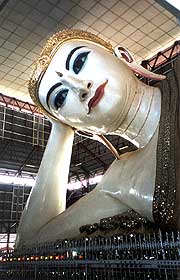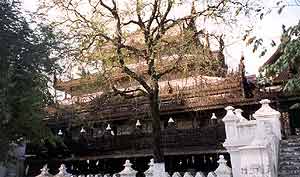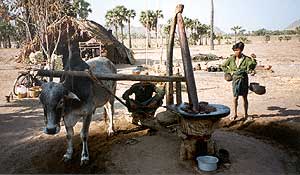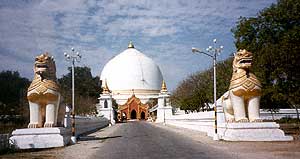|
The Third Burmese Empire The Mon
conquest of Ava was short-lived. The Southerners were unpopular
and within a year of taking the city, they had a revolt on their
hands. Alaungpaya, a local official from the nearby town of
Shwebo, refused to swear allegiance to the Mons and with the
help of a large following he recaptured Ava in 1753. Within 4
years, Pegu had also fallen to Alaungpaya's forces; the Mon fled
to the small town of Dagon, to the SW. Three years later,
Alaungpaya sacked the town, renaming it Yangon -'the end of
war'. But it was not the end of war, having conquered the Mons,
Alaungpaya attacked Ayutthaya. He was fatally wounded in the
process, in 1760. But in his few short years as King of Burma, he had founded the Konbaug
Dynasty, and with it, the Third (and final) Burmese Empire. The dynasty lasted for over a century (1752-1865), during which time the capital - which was first at Shwebo - shifted between Ava (1765-1783, 1823-1837) and Amarapura (1783-1823, 1837-1857) before moving to Mandalay in 1857.
Alaungpaya's second son, Hsinbyushin, came to the throne after a short reign by his elder
brother, Naungdawgyi (1760-1763). He continued his father's expansionist policy and finally took Ayufthaya in 1767, after 7 years of
fighting. He returned to Ava with Siamese artists, dancers, musicians and craftsmen who gave fresh cultural impetus to Burma. The Mons had been crushed and the Shan
Sawbwas (feudal
lords) were made to pay tribute to the Burmese. The kingdom's NE borders came under threat from the Chinese - they invaded 4 times between 1765 and 1769 but were repulsed on each
occasion. In 1769 King Hsinbyushin forced them to make peace and the 2 sides signed a
treaty. Europeans began to set up trading posts in the Irrawaddy delta region at this time; the French struck deals with the Mon while the English made agreements with the Burmese.
| Bodawpaya, Alaungpaya's 5th son, came to the throne in 1782. He founded
Amarapura, moving his capital from Ava. Bodawpaya conquered Arakan in 1784 and recovered all the Burman treasures taken by the Arakanese 2 centuries
before, including the Mahamuni image. Burmese control over Arakan resulted in protracted wrangles with the British, who by then were firmly ensconsed in
Bengal. Relations with the British deteriorated further when Bodawpaya pursued Arakanese rebels seeking
refuge, across the border - this was not to be the last time refugees flooded over the
border. Conflict ensued; the British wanted a demarcated border while the Burmese were content to have a zone of overlapping
influence. to add to their annoyance, British merchants complained about being badly treated by the king's officials in Rangoon. The British decided enough was enough and diplomatic relations were severed in 1811. Bodawpaya turned his attention to the administration of his
empire. He investigated the existing tax systems and revoked exemptions for religious establishments which incurred the wrath of the monk hood - as did his claim to be a
Bodhisattva. |
 |
Bodawpaya died in 1819 at the age of 75 and was succeeded by King
Bagyidaw. The Maharajah of Manipur (a princely state in the W hills to the S of Nagaland) who previously paid tribute to the Burmese
crown, did not attend Bagyidaw's coronation. This resulted in the subsequent expedition that took the Burmese into British
India.
The expansion of the British into Burma This intrusion was used by the British as a pretext for launching the First Anglo-Burmese War. The British took Rangoon in 1824 and then advanced on Ava. In 1826, the Burmese agreed to the British peace terms and the Treaty of Yandabo was
signed. This ceded the Arakan and Tenasserim regions to the British -which were ruled from
Calcutta, headquarters of the British East India Company. Manipur also became part of British
India.
But the peace treaty did little to ease relations between the British and Burmese. The Burmese kings felt insulted at having to deal with the viceroy of India instead of British royalty In 1837 King Bagyidaw's brother, Tharrawaddy, seized the throne and had the queen, her brother, Bagyidaw's only son, his family and ministers all executed. He made no attempt to improve relations with Britain, and neither did his successor to the Lion Throne, Pagan Min, who became king in 1846. He executed thousands - some history books say as many as 6,000 - of his wealthier and more influential subjects on trumped-up charges. During his reign, relations with the British became increasingly strained. In 1852, the Second Anglo-Burmese War broke out after 2 British shipmasters complained about unfair treatment. They had been imprisoned having been charged with murder and were forced to pay a large 'ransom' for their release. British military action was short and sharp and within a year they had taken control of Rangoon and Prome and announced their annexation of Lower Burma. Early in 1853, hostilities ceased, leaving the British in full control of trade on the Irrawaddy. The same year - to the great relief of both the Burmese and the British - Pagan Min was succeeded by his younger brother, the progressive Mindon Min.
The British were amazed at life in the Burmese court: the strict rules of protocol prompted much debate, particularly 'the shoe question�. The British where indignant at having to take off their shoes on entering pagodas and while having an audience with the king. They were amused by the ritual quandary surrounding the decision of which umbrella the king should use, but nothing bemused them more than the status accorded the white elephant. The 'Lord White Elephant'- or Sinbyudaw- commanded social status second only to the king in the hierarchy of the royal court. Sinbyudaw were treated with reverence and had white parasols held over them wherever they went. Young white elephants were even suckled by women in the royal court who considered it a great honour to feed the elephant with their own milk.

A new king moved the capital to Amarapura and then to his new city of Mandalay. The move was designed to
fulfill a prophesy of the Buddha that a great city would one day be built on the site. Court astrologers also calculated that Mandalay was the centre of the universe - not Amarapura. King Mindon attempted to bring Burma into greater contact with the outside world: he improved the administrative structure of the state, introducing a new income tax; he built new roads and commissioned a telegraph system; he set up modern factories using European machinery and European managers. He also sent some of his sons to study with an Anglican missionary and did all he could to repair relations with Britain. A commercial treaty was signed with the British, who sent a Resident to Mandalay. King Mindon hosted the Fifth Great Buddhist Synod in 1872 at Mandalay. In these ways he gained the respect of the British and the admiration of his own people.
The Burmese found the foreign presence in Mandalay hard to tolerate and with the death of Mindon, the atmosphere thickened. King Mindon died before he could name a successor, and Thibaw, a lesser prince, was manoeuvred onto the throne by one of King Mindon's queens and her daughter, Supayalat. (In his poem The Road to Mandalay, Rudyard Kipling remarks that the British soldiers referred to her as 'Soup-plate'.) In true Burmese style, the new King Thibaw proceeded, under Supayalat's direction, to massacre all likely contenders to the throne. His inhumanity outraged British public opinion. London was becoming increasingly worried by French intentions to build a railway between Mandalay and the French colonial port of Haiphong in Annam (N Vietnam). When Thibaw provoked a dispute with a British timber company, the British had the pretext they needed to invade Upper Burma. In 1886 they took Mandalay and imposed colonial rule throughout Burma; Thibawand Supayalat were deposed and exiled to Madras in S India. Supayalat was eventually buried at the foot of the Shwedagon pagoda in Rangoon as the British feared nationalist rebellion if the funeral took place in Mandalay.

British colonial rule Burma was known as 'Further India' and was run on the principle of 'divide and rule'. The colonial administration relied heavily on Indian bureaucrats and by 1930 - to the resentment of the Burmese - Indian immigrants comprised 1/2 the population of Rangoon. The British permitted the country's many racial minorities to exercise limited autonomy. Burma was divided into 2 regions: Burma proper, where Burmans were in a majority - which included Arakan and Tenasserim - and the hill areas, inhabited by other minorities. The Burmese heartland was administered by direct rule. The hill areas - which included the Shan states, the Karen states, and the tribal groups in the Kachin, Chin and Naga hills - retained their traditional leadership, although they were under British supervision. These policies gave rise to tensions that continue to plague today's government.
The colonial government built roads and railways, and river steamers, belonging to the Irrawaddy Flotilla Company, operated between Rangoon and Mandalay. The British brought electricity to Rangoon, improved urban sanitation, built hospitals and redesigned the capital on a grid system.
While the British set about building and modernizing, they benefited greatly from an economic boom in the Irrawaddy delta region. When they first arrived in Burma, much of the delta was swampland. But under the British, Burmese farmers began to settle in the delta and clear land for rice cultivation. In 1855, paddy fields covered 400,000 ha; by 1873 the forests had been cleared sufficiently to double the productive area. Land under rice cultivation increased by another 400,000 ha roughly every 7 years, reaching 4 million ha in 1930. Population in the area - which was about 1.5 million in the rnid-1 9th century- increased more than 5-fold.
Initially the rice paddies were farmed by Burmese smallholders but as rice prices rose, larger holdings were bought up and large tracts of land cleared by pioneers from central Burma. The agricultural economy in the delta region was dependent on complex credit facilities, run by Indian Chettiars - S Indian money-lenders - who extended credit to farmers at much lower rates than Burmese money-lenders. The Chettiars grew into a very prosperous community. Land rents had risen dramatically during the boom years and when the world economic depression set in in the 1930s, rice prices slumped and small-holders went bust. Between 1930 and 1935, the amount of land owned by the Chettiars trebled in size due to foreclosures, leaving them with well over a 1/4 of the delta's prime land. The agrarian crisis triggered anti-Indian riots, which started in Rangoon in May 1930 and then spread to the countryside.
From the beginning of the colonial period, the British stressed the benefits of education, and formal Western-style schooling replaced the traditional monastic education system. Rangoon University was founded in 1920 and a new urban 61ite evolved. They attempted to bridge the gap between old and new Burma by calling for the reform of traditional Buddhist beliefs and practices. In 1906, the Young Men's Buddhist Association was established in an effort to assert Burmese cultural identity and remain distinct from their colonizers. In 1916, the YMBA objected to the fact that Europeans persisted in wearing shoes inside religious buildings, which was considered disdainful. After demonstrations in over 50 towns, the government ruled that abbots should have the right to determine how visitors should dress in their monasteries - a ruling hailed as a victory for the YMBA.
Following the introduction of greater self-government in India and the spread of Marxism, the YMBA renamed itself the General Council of Burmese Associations and demanded more autonomy for Burma. A strike was organized at Rangoon University the year it was founded, and this spread across the country as schools were boycotted. The most serious uprising was initiated by a monk called Saya San; it represented the first concerted effort to expel the British by force. From 1930-1932, during what became known as the Saya San Rebellion, 3,000 of his men were massacred and 9,000 taken prisoner, while the government suffered casualties of only 138. Saya San was hanged in 1937. The underground nationalist movement also gained momentum in the 1930s and at the University of Rangoon the All-Burma Student Movement emerged. The colonial regime was clearly shaken by the extent of the unrest and the level of violence and in 1935 the Government of Burma Act finally granted Burma autonomy. In 1936, the groups' leaders - Thakin Aung San and Thakin Nu - led another strike at the university. They called themselves Thakin as it was previously an honorific only used to address Europeans. In 1937 Burma was formally separated from British India. It received its own constitution, an elected legislature and 4 popular governments served until the Japanese occupation.
During World War 2 Japan invaded Burma in 1942, helped by the new burmese independence army (BIA) - a band of men secretly trained by the Japanese before the war and led by Aung San, who had emerged as one of the outstanding leaders during the student riots in Rangoon. The BIA grew in number from 30 to 23,000 as Japan advanced through Lower Burma. The Burmese saw the Japanese occupation as a way to expel the British colonialists and to gain independence. The British were quickly overwhelmed by the rapid advance of the Japanese 15th Army and fled to India. Their scorched earth policy - which involved torching everything of value and sabotaging the infrastructure they had built up over decades - left total devastation in their wake. Fierce guerrilla warfare erupted between the British and the Japanese and BIA, in which casualties were high - as many as 27,000 may have died. Many of the British and Allied troops who died - most in the hand-to-hand combat - are buried at the Htaukkyan cemetery near Rangoon.
The war produced many heroes. Stilwell, an American, having retreated through the jungle into India with 114 men, retraced his steps (through Assam, across the Chindwin River to Myitkyina, and down the Irrawaddy to Mandalay) and helped recapture Rangoon in May 1945. Wingate, a British war-hero, used guerrilla tactics to successfully penetrate the Japanese lines. His men were known as the Chindits - after the mythological Chinthes, the undefeatable temple lions. Chennault was another hero, who led the airborn division - nicknamed 'the Flying Tigers' - who were feared by the Japanese. US ground forces in Burma were known as 'Merrill's Marauders' and consisted of about 3,000 men, of which all but a handful were killed.
The 800 km-long Ledo Road -from Assam to Mong Yo, where it joins the Burma Road (see page 368) - was built during the war by 35,000 Burmese and several thousand engineers, to enable a land force to enter Burma from India.
But on 19 July, a few months before Burma was to be granted full independence, Aung San and 5 of his ministers were assassinated while attending a meeting in the Secretariat in Rangoon. U-Saw, a right-wing prime minister in the pre-war colonial government was convicted of hatching the plot, and executed; he had hoped to create a leadership role for himself. It was a tragedy for Burma as Aung San seemed best equipped to unite the many different factions and minorities; had he lived, post-war Burmese history may have taken a very different course.
Back to
History
|




